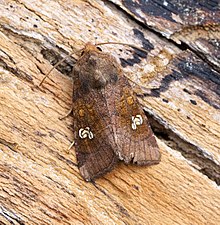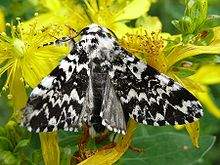Noctuidae
| Owlet moths | |
|---|---|
 |
|
| Amphipoea oculea | |
 |
|
| Panthea coenobita | |
| Scientific classification | |
| Kingdom: | Animalia |
| Phylum: | Arthropoda |
| Class: | Insecta |
| Order: | Lepidoptera |
| Superfamily: | Noctuoidea |
| Family: |
Noctuidae Latreille, 1809 |
| Type species | |
|
Noctua pronuba |
|
| Subfamilies | |
|
Acontiinae |
|
| Diversity | |
| About 11,772 | |
Acontiinae
Acronictinae
Aediinae
Agaristinae
Amphipyrinae
Bagisarinae
Balsinae
Bryophilinae
Condicinae
Cuculliinae
Dilobinae
Dyopsinae
Eucocytiinae
Eustrotiinae
Heliothinae
Metoponiinae
Noctuinae
Pantheinae
Plusiinae
Raphiinae
The Noctuidae, commonly known as Owlet moths, Cutworms or Armyworms, is the most controversial family in the superfamily Noctuoidea especially because many of its clades are constantly changing along with the other families of Noctuoidea. It was considered the largest family in Lepidoptera for a long time, but after regrouping Lymantriinae, and Calpinae within the Family Erebidae, which took this title now. Currently, Noctuidae is now the second largest family in Noctuoidea with about 1,089 genera and 11,772 species. However, this classification is still unfinished as more changes continue to appear between Noctuidae and Erebidae.
Adult: Noctuid adults most have drab wings, but some subfamilies as Acronictinae and Agaristinae are very colorful especially those form Tropical regions (e.g. Baorisa hieroglyphica). Also they are characterized by a structure in the metathorax called nodular sclerite or epaulette, which separate the tympanum and the conjunctiva in the tympanal organ. And it also has another function that is keep out the parasites (Acari) from tympanal cavity. Another characteristic in his group is trifine hindwing venation by reduction or absence of the second medial vein (M2).
...
Wikipedia
